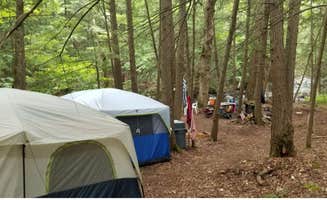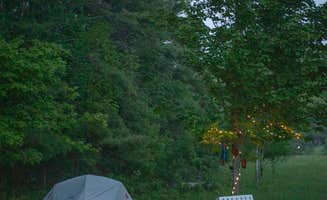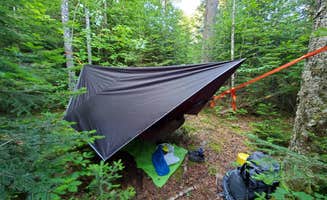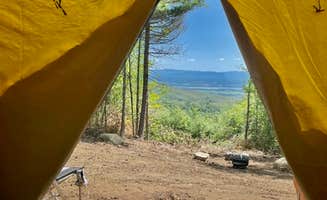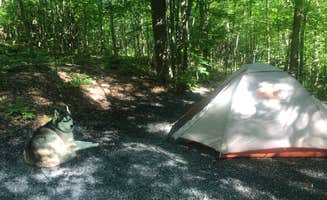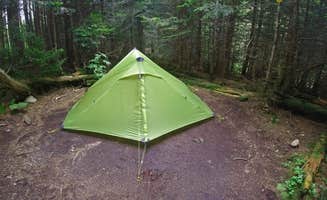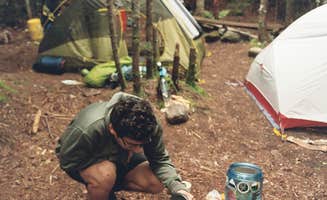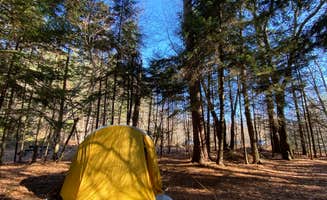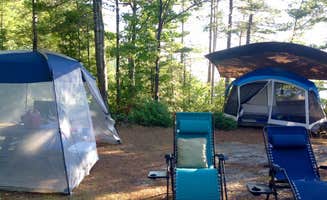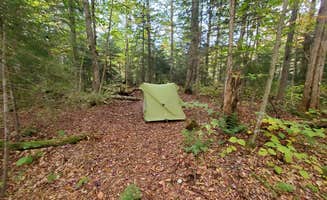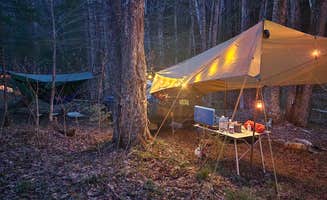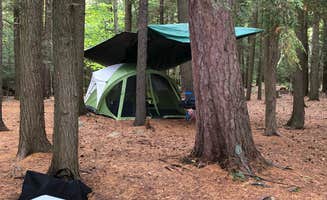Tent camping opportunities around Witherbee, New York range from free backcountry sites to established campgrounds with more amenities. Many sites sit at elevations between 2,000-4,000 feet, creating temperature variations that can be 10-15°F cooler than surrounding lowlands. Trails in this region often follow rocky, root-covered paths requiring proper footwear and hiking poles for stability when carrying camping gear.
What to do
Mountain summit hikes: Multiple backcountry campsites serve as starting points for High Peaks adventures. The Feldspar Lean-to provides access to Mt. Marcy, with campers noting "If you're coming from Marcy Dam by way of Lake Colden, this campsite is a great spot to stop for the night on the way to Mt. Marcy." Snowbird Campsite offers unique positioning for the challenging HaBaSa trail. According to one camper, "It's great when you hike the HaBaSa trail (haystack, basin, saddleback) since it's right after Haystack and not too far from Basin."
Swimming holes: Several campsites feature natural swimming spots for cooling off during summer months. The Lillian Brook Campground offers "the Lillian brook flowing right next to it" with "clear water with big rock pool to swim in (COLD)." Bushnelle Falls Campsite provides both camping options and water features, with one reviewer mentioning it's a "great campsite near the river and a huge falls too."
Lake activities: Heart Lake offers water-based recreation opportunities at established campgrounds. A visitor noted the Wilderness Campground at Heart Lake has "a beautiful lake here for doing all sorts of things at" and another mentioned "we had a very pleasant stay here and personally found the weekdays to be best for 'camp days' given there were few people."
What campers like
Privacy between sites: Many tent campers appreciate the spacing and layout at various campgrounds. At Mount Philo State Park Campground, "sites are widely spaced wooded sites and was exceptionally quiet." Another camper reported: "Sites 1, 6 and 8 and the best if you're only camping with those at your site as they're the most secluded and private." Even at the more popular Heart Lake campground, "the sites are spaced out and people were very respectful of noise/lights/other campers."
Lean-to options: The Adirondack region offers numerous lean-to structures at backcountry and established sites. One camper described the Flowed Lands experience: "We camped in the Calamity Lean to for 3 nights on a school trip, and it was my favorite site we stayed at on the trip. The view of the lake is stunning, and there's a quick walk down to the edge of the lake." Feldspar offers "one lean-to and 3 campsites" while Bushnelle Falls features "lots of tent sites and 2 lean-to."
Proximity to trails: The best tent camping near Witherbee, New York often connects directly to hiking routes. Marcy Dam Backcountry Campsites are "conveniently located near the trails for Mt. Marcy, Mt. Colden, and Avalanche Pass" and a camper noted Flowed Lands provides access where "the trail to Mt. Skylight and Mt. Marshall are both close enough to hike in the day."
What you should know
Facilities and water access: Campground amenities vary significantly throughout the area. At Wilderness Campground at Heart Lake, campers will find "two wash houses with showering and bathroom amenities that are cleaned weekly" and "multiple water fill stations sprinkled throughout the campground area." In contrast, at Marcy Dam Backcountry Campsites, there are "no toilets or piped water. No firepits, and you cannot start fires here - bring your stove."
Seasonal considerations: The high elevation affects camping conditions throughout the year. Snowbird Campsite sits at a high elevation, and a camper warned "it's windy and colder at night." At Heart Lake, one visitor reported they "braved the 12° nights and pitched a tent" while another noted their March visit found "a decent amount of snow on the site. Despite the lake being frozen over, the views just steps away from our lean to were gorgeous."
Site availability: First-come, first-served sites fill quickly, especially in popular areas. For Marcy Dam, "on summer weekends, all the sites can fill up pretty quickly by Friday night." Another camper noted during their trip, "it did appear that you would be able to drive in without reservation on a weekday and find yourself a site" at Heart Lake, but "weekends are PACKED."
Tips for camping with families
Choose established campgrounds: Families often prefer sites with more amenities. Mount Philo State Park Campground was described by one camper: "We visited and camped here 3 years ago with children. We love how private the camp sites were. There are less than 20 sites total, and all sites are near walk-in paths to excellent views."
Consider water access for recreation: Areas with swimming options keep children entertained. A visitor to Flowed Lands shared: "The lake is gorgeous, although it wasn't as big as I thought it was going to be. The campsites are close to the water, which makes for a great wake up call in the morning. I loved un-zipping my tent and seeing the lake first thing in the morning."
Prepare for bugs: Insects can be problematic, particularly for families with young children. A camper at Flowed Lands advised: "I would also recommend bringing bug spray because the mosquitos were pretty killer, even in late August."
Tips from RVers
Road condition awareness: Access roads to many sites require careful navigation. One RVer at Davey Falls ADK described it as an "amazing secluded creekside spot" but noted accessibility challenges. Another camper at Heart Lake warned, "beware of the roads coming in. 40MPH is too fast for these torn up roads."
Size limitations: The High Peaks region has few RV-friendly sites. Mount Philo has restrictions where "because the road is steep and winding, it's not suitable for RVs." Most backcountry and primitive camping areas are tent-only, with Heart Lake being one of the few locations offering limited RV camping options.
Seasonal availability: RV camping is further restricted by weather conditions. Most unpaved access roads become difficult or impassable during spring thaw or after heavy rainfall, and many campgrounds close entirely during winter months.


